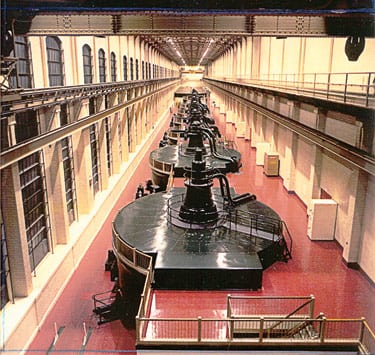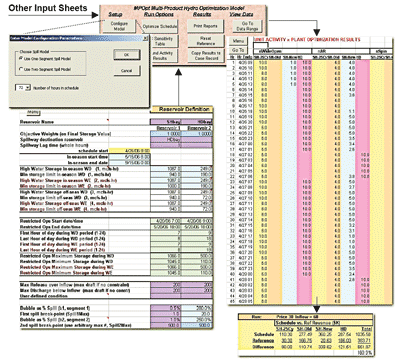Computer-based hydro plant scheduling
Hydroelectric power plant managers face unique scheduling challenges. They have a finite amount of water in their reservoirs available for energy production, and they need to schedule generation according to market demand to maximize profits from their limited “fuel” supply.
Hydro power plants are capable of producing products other than electricity. Among them are ancillary services such as regulation and spinning reserve, which plant managers need to consider when they schedule production. Daily and hourly changes in market price and regulatory constraints on reservoir levels are other factors. In the context of this complexity, plant managers must bid their mix of products on an hourly and daily basis, and their offering must be both competitive and profitable.
To optimize this complex production-scheduling problem, most hydro plants rely on general rules and operator experience. However, these methods do not take advantage of economic opportunities that present themselves on a daily and hourly basis.
As the Pennsylvania, New Jersey, and Maryland Interconnection (PJM) became the most active and liquid market for bulk power in the U.S., Safe Harbor Water Power Corp. (Conestoga, Pa.) recognized the opportunity to use a computerized method of optimizing its production scheduling to maximize its profits. The Safe Harbor station (Figures 6 and 7) is a 12-unit facility with an installed capacity of 417 MW. Immediately below it is the reservoir for the Holtwood plant, which has 10 units with a total capacity of 115 MW.
|
6. Water under the bridge. The advent of regional, online wholesale electricity markets created an opportunity for Safe Harbor Water Power Corp. to optimize the performance of its hydro plants. Courtesy: Safe Harbor Water Power Corp.
|
|
7. An even dozen. The Safe Harbor plant has 12 units with a total installed capacity of 417 MW. Courtesy: Safe Harbor Water Power Corp.
|
An automated solution
To enable automated scheduling and bidding of a multi-plant, multi-product hydropower system into PJM, Safe Harbor implemented the Multi-product Hydro Optimization Tool (MPOpt). The application, which was designed by the management consulting firm and service-product developer Atelier (Menlo Park, Calif.), uses Microsoft Excel and the Premium Solver Platform (PSP) from Frontline Systems Inc. (Incline Village, Nev.; on the web at www.solver.com). Atelier used several unique features of PSP to model this complex problem in a way that allows MPOpt to optimize even the most complex schedules in under five minutes.
As a result of implementing MPOpt, Safe Harbor:
- Increased its revenue by more than 30% by aggressively pursuing the emerging ancillary services markets for regulation and spinning reserve.
- Improved its maintenance schedules by minimizing the lost opportunity cost of plant downtime.
- Gained a valuable tool for quantifying the impact of proposed changes to government regulations for reservoir operations.
- Replaced historical operating policies that were suboptimal—one was “not allowing spill, when possible.”
- Positioned itself as a leader in the PJM market for ancillary services.
“The use of a computerized optimization tool took the guesswork out of our daily production scheduling and greatly increased our profits,” said Safe Harbor President and CEO Marshall Kaiser. “Our hydro schedulers create optimal hourly schedules for three products from two power plants in minutes, which would be impossible with manual methods. The ability to also quickly run ‘what if’ scenarios has provided insight into our operations that we would not have gained without the tool. Optimization led us into the ancillary services business and ultimately helped us identify novel ways to increase our plants’ capacity to produce these products.”
Modeling for speed
Atelier chose PSP for its ability to quickly solve problems that include binary variables. Binary variables are important tools for representing the discrete business conditions that constrain business processes. They can be instrumental in representing a complex nonlinear process so that it can be solved quickly in an operations environment.
For example, Atelier used the binary variable features of PSP to mathematically model the nonlinear behavior of water as it spills over a spillway. By representing model nonlinearities in both plant efficiency and water behavior, MPOpt can run a case in just a few minutes, as opposed to several hours, as was required by other hydro power system models. The schedules produced using the piecewise linear spill model that Atelier developed with PSP can meet the required reservoir elevations within one-tenth of a foot, which is the tolerance allowed by the regulatory agency. As Atelier continued to add capabilities to MPOpt, performance enhancements included in Frontline’s software releases kept up with the need to run the model in fewer than five minutes.
MPOpt can schedule up to four systems (reservoirs and plants) in a variety of configurations. Safe Harbor uses MPOpt to schedule two plants and two reservoirs on the Susquehanna River as a coordinated system.
Schedule options
Scheduling and bidding at Safe Harbor is a daily routine organized around MPOpt (Figure 8). By 8:00 a.m. each day, Safe Harbor loads the following inputs into MPOpt:
- An hourly forecast of total expected energy demand on PJM over the next five days. The forecast is prepared by PJM using its own model of market demand based on weather and other factors.
- Reservoir elevations at the start of the scheduling horizon.
- An hourly forecast of river inflow to the reservoirs, based on data from monitoring stations throughout Safe Harbor’s watershed area.
- Any necessary updates to unit availability or reservoir operating constraints—for example, whether reservoir elevations should be restricted to ensure the safety of staff working on the dam during the schedule horizon.
|
8. It optimizes revenues, too. Safe Harbor implemented the Atelier-designed MPOpt to model the complexities of the multi-unit hydro plant such that even the most complex schedules can be optimized in fewer than five minutes. Source: Atelier
|
A module within MPOpt automatically forecasts market prices for each of the three products based on the hourly forecast for total energy demand in the PJM system.
Between 8:00 a.m. and 10:00 a.m., Safe Harbor hydro schedulers run MPOpt several times. With each run, they tune various calibration parameters, such as selecting an appropriate “day-type” for the price forecast model and adjusting other parameters to reflect real-time market conditions. The hydro schedulers may also run a bidding module that uses PSP to determine optimal bid prices. The Safe Harbor scheduling team then submits to the ISO by noon bid schedules and prices for the “day ahead” market, which is the 24 hours beginning at midnight. PJM provides the bidding results to all market participants that afternoon.
Benefits of profit optimization
Some of the results that MPOpt produces are counterintuitive. For example, the software sometimes recommends:
- Production at less than full capacity when demand and price are at their daily peak. Doing so would be more profitable because together, selling regulation during the peak hour and using the water saved to produce energy and regulation at a different hour would more than make up for the lost revenue.
- Running the larger upstream plant harder than the smaller downstream plant, producing a water spill at the latter. MPOpt may even suggest that the downstream plant spill even more water than necessary so it can sell regulation, too.
- Emptying a reservoir during a heat wave and waiting for it to refill over subsequent days, in the anticipation that cooler weather will mean lower demand and lower prices. This would be a bolder move than historical operating policy, and one that staff may not be comfortable with.
In each case, MPOpt can quantify the additional profit that can be achieved from the suggested schedule, vis-à-vis the schedule that traditional operating policies would have produced. After seeing the results, Safe Harbor updated its operating policy and overturned long-standing rules of thumb—such as the rule to avoid spill.
Insights like these, which only modeling can provide, helped Safe Harbor to realize the potential of computer-based profit optimization. Implementing an optimization tool can also produce other benefits. At Safe Harbor, implementing daily profit optimization helped staffers think more about ways to improve operations. As a result, they identified a method for Safe Harbor to increase its production of regulation without adding capacity—by simply changing how the plant’s control system works.
—Contributed by Louis B. Deziel, PhD, founder and principal of Atelier (www.atelier.com); Marshall Kaiser, president and CEO, Safe Harbor Water Power Corp. (www.shwpc.com); and Dan Fylstra, president and CEO, Frontline Systems Inc. (www.solver.com).


